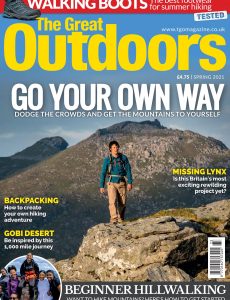
The Great Outdoors – Spring 2021
English | 102 pages | pdf | 24.25 MB
Welcome The Great Outdoors magazine Spring 2021 issue
WE HAD THE TOP of England’s second highes mountain to ourselves. And in the time it had taken us to walk there – up Esk Gorge, with its booming waterfalls and diamond-clear plunge pools, and over the empty expanse of Great Moss – we had seen two or three people. This was on a sunny Saturday. In July. We lingered awhile, peering over Scafell’s plunging crags, admiring the view of Wast Water stretching towards the sun-hazed Irish Sea, and marvelling at the difference in numbers between this summit (us two) and the slightly higher one about half a kilometre away (40+). That other summit was, of course, the roof of England itself: Scafell Pike.
There is plenty of room in the hills. But it might not always seem like it. Even before this last year, when enjoyment of ‘the outdoors’ has surged as other liberties have been curtailed, the mountains seemed busier than ever. Every sunny Bank Holiday, it’s almost become a national pastime to express outrage at photos of giant lines of people stretching up to the summits of Snowdon or Pen y Fan.
Personally, it gives me a kind of patriotic pride to see British people literally taking their love for queueing to new heights; but not everyone feels that way. Judging by Twitter, at least, reactions to such images range from incredulity to revulsion and even contempt. Clearly, these folk just aren’t doing hillwalking ‘right’.
Lurking somewhere is a fear of the countryside somehow being overwhelmed by the wrong ‘sorts’. A commenter on Twitter recently responded to an article I’d written on alternatives to popular mountains by saying: “The more you tell them, the more certain mass invasion will happen”. Mass invasion? What year is it, 1940?
I don’t seek to downplay the challenges we face as the countryside opens up again (a survey this month, for example, found that 58% of people in Scotland intend to spend more time outside in the future). It sickens me as much as anyone to see abandoned tents and excrement-covered beauty spots. But education, investment and effective enforcement (rather than, say, blanket bans targeting all wild campers) are the solution, not knee-jerk and exclusionary attitudes.
Concerns about the overrunning of the countryside by the masses are nothing new. “Is there no nook of English ground secure from rash assault?” fumed Wordsworth in 1844, protesting against the construction of a railway to Windermere. Almost two centuries later, despite 20 million visitors coming to the Lake District every year, the region is still far from being truly overwhelmed. Know where to look (hint: go west) and you can still easily find levels of solitude that would make even Wordsworth feel cloudlike levels of loneliness.
So that’s what this issue of The Great Outdoors Magazine is about. My Scafell story is just one example of how concentrated the ‘honeypot effect’ can be: get off the beaten track, even by just a little, and you can often be amazed by how quiet everything is. For more inspiration along these lines,
I commend to you excellent features by James Forrest (p12), Nicola Hardy (p32), Craig Weldon (p42) and Alex Roddie (p48), all of which show, in different ways, that there is more than enough room out there for all of us – even in little Britain. And for good measure, Faraz Shibli’s awesome feature on his crossing of the Gobi Desert (p56) is a reminder that there are still places on the planet where space and sublime nature can be found in wonderful abundance.
Carey Davies, Editor
@carey_davies
www.tgomagazine.co.uk
Download from: